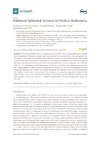Identificador persistente para citar o vincular este elemento:
https://accedacris.ulpgc.es/jspui/handle/10553/106609
| Campo DC | Valor | idioma |
|---|---|---|
| dc.contributor.author | León, Germán | en_US |
| dc.contributor.author | Herrán, Luis F. | en_US |
| dc.contributor.author | Mateos, Ignacio | en_US |
| dc.contributor.author | Villa, Enrique | en_US |
| dc.contributor.author | Ruiz Alzola, Juan Bautista | en_US |
| dc.date.accessioned | 2021-04-08T07:05:23Z | - |
| dc.date.available | 2021-04-08T07:05:23Z | - |
| dc.date.issued | 2020 | en_US |
| dc.identifier.issn | 1424-8220 | en_US |
| dc.identifier.uri | https://accedacris.ulpgc.es/handle/10553/106609 | - |
| dc.description.abstract | Microwave thermometry is a noninvasive and passive technique for measuring internal body temperature. Wearable compact antennas, matched to the specific body area, are required for this method. We present a new epidermal wideband antenna for medical radiometry. The double asymmetric H-shaped slot antenna was designed to be matched to di erent parts of the body without fat layers. The slots are fed by a short-circuited microstrip line in order to decrease size and back radiation, thus reducing potential interferences. In this way, contribution to radiometric temperature due to back radiation is lower than 4%, versus the 20% of the volume under investigation, over the whole operating frequency band. The designed prototype was manufactured on a flexible substrate. The antenna is a very small size, to make it comfortable and suitable for being used by patients with di erent body mass indexes. The double H-shaped antenna shows good wideband matching results from around 1.5 GHz up to 5 GHz, in di erent body locations such as the neck, foot instep and foot sole. | en_US |
| dc.language | eng | en_US |
| dc.relation.ispartof | Sensors (Switzerland) | en_US |
| dc.source | Sensors (Switzerland) [ISSN 1424-8220], n. 20 | en_US |
| dc.subject | 3314 Tecnología médica | en_US |
| dc.subject.other | Epidermal antenna | en_US |
| dc.subject.other | Flexible wideband antenna | en_US |
| dc.subject.other | Microwave medical applications | en_US |
| dc.title | Wideband Epidermal Antenna for Medical Radiometry | en_US |
| dc.type | info:eu-repo/semantics/Article | en_US |
| dc.identifier.doi | 10.3390/s20071987 | en_US |
| dc.identifier.issue | 7 | - |
| dc.investigacion | Ingeniería y Arquitectura | en_US |
| dc.type2 | Artículo | en_US |
| dc.utils.revision | Sí | en_US |
| dc.identifier.ulpgc | Sí | en_US |
| dc.contributor.buulpgc | BU-TEL | en_US |
| dc.description.sjr | 0,636 | |
| dc.description.jcr | 3,576 | |
| dc.description.sjrq | Q2 | |
| dc.description.jcrq | Q1 | |
| dc.description.scie | SCIE | |
| item.grantfulltext | open | - |
| item.fulltext | Con texto completo | - |
| crisitem.author.dept | GIR IUIBS: Patología y Tecnología médica | - |
| crisitem.author.dept | IU de Investigaciones Biomédicas y Sanitarias | - |
| crisitem.author.dept | Departamento de Señales y Comunicaciones | - |
| crisitem.author.orcid | 0000-0002-3545-2328 | - |
| crisitem.author.parentorg | IU de Investigaciones Biomédicas y Sanitarias | - |
| crisitem.author.fullName | Ruiz Alzola, Juan Bautista | - |
| Colección: | Artículos | |
Citas de WEB OF SCIENCETM
Citations
5
actualizado el 08-jun-2025
Visitas
114
actualizado el 30-mar-2024
Descargas
41
actualizado el 30-mar-2024
Google ScholarTM
Verifica
Altmetric
Comparte
Exporta metadatos
Los elementos en ULPGC accedaCRIS están protegidos por derechos de autor con todos los derechos reservados, a menos que se indique lo contrario.
